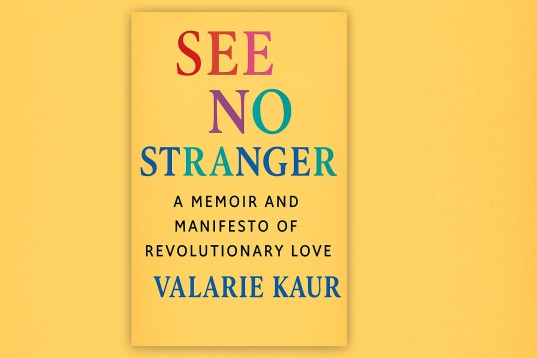A Luminous Review of See No Stranger by Valarie Kaur
BOOKS REVIEW
Chaifry
10/1/20254 min read


Valarie Kaur, a renowned civil rights lawyer, filmmaker, and Sikh activist born in Clovis, California, in 1981, has dedicated her life to weaving love into justice. An alumna of Stanford University and Yale Law School, Kaur founded the Revolutionary Love Project in 2017 to counter hate with empathy. Her TED Talk on revolutionary love has over 5 million views, and her work has been featured in The New York Times, Washington Post, and Oprah Magazine. Her 2020 book, See No Stranger: A Memoir and Manifesto of Revolutionary Love, published by One World, is a blend of personal memoir and call to action. A New York Times bestseller, it's been called “a luminous, powerful guide” by The Washington Post (2020) and “a blueprint for the future” by The Guardian (2020), offering hope in divided times.
The book's main idea is that revolutionary love—rooted in Sikh teachings of seeing no stranger—is a practice of empathy, grief, and daring to fight injustice, transforming personal pain into collective strength. It’s a wake-up call to the ground reality that hate thrives on disconnection, making it a must-read for its heartfelt, actionable vision of love as labor. For Indian youngsters, it’s like a friend over chai, sharing how to stand against “log kya kahenge” with kindness. This memoir invites everyone to see the stranger as part of us, a gentle guide for a world playing catch-up with compassion.
See No Stranger opens with Kaur's invocation: “You are a part of me I do not yet know” (Kaur, 2020, p. 1). Kaur argues that revolutionary love—wonder, grief, daring, and decision—counters oppression, using her life and Sikh teachings as evidence. “I see no stranger. I see no enemy” (p. 10), Guru Nanak’s words, anchor the book. The memoir starts with her grandmother: “Dadi was my first teacher of love” (p. 15).
Kaur's childhood in California: “Racial slurs were my first lessons in hate” (p. 25). “Deep listening is an act of surrender” (p. 30). Post-9/11: “Sikhs became targets overnight” (p. 40). “Rage is a healthy, normal, and necessary response to injustice” (p. 50). Her grandmother's death: “Grief is the price of love” (p. 60).
Kaur's activism begins: “I marched for justice, but love was the key” (p. 75). “If love is sweet labor, love can be taught, modeled, and practiced” (p. 85). The four practices of love: wonder, “You don't need to know people in order to grieve with them. You grieve with them in order to know them” (p. 100). Grief: “Unresolved grief inside a person is tragic; unresolved grief inside a nation is catastrophic” (p. 115). Daring: “Love is public, disruptive, and dangerous” (p. 130).
Decision: “Choose to love, even when it hurts” (p. 145). Kaur's pregnancies: “Motherhood taught me love's labor” (p. 160). “The womb is a revolution of love” (p. 175). The book ends with a manifesto: “Revolutionary love is the call of our time” (p. 190). “See no stranger, and the world changes” (p. 205). Kaur uses memoir and activism to show love's power.
See No Stranger excels in its lyrical memoir and urgent manifesto, blending personal and political with grace. Kaur’s prose is poetic: “You are a part of me I do not yet know” (p. 1) opens with wonder. The book's strength is its four practices: “Deep listening is an act of surrender” (p. 30) structures love as labor, as The Washington Post (2020) calls it “luminous.” The grief chapter, “Grief is the price of love” (p. 60), is profound.
The activism, “Rage is a healthy, normal, and necessary response to injustice” (p. 50), is bold. The warmth in family, “Dadi was my first teacher of love” (p. 15), feels intimate. Its global appeal lies in love's universality.
Weaknesses include a U.S.-centric focus: “Sikhs became targets overnight” (p. 40) overlooks global Sikh experiences. Intersectional analysis is strong on race and gender but lighter on class: “The womb is a revolution of love” (p. 175) centers motherhood but skips economic barriers. The optimism, “Love is public, disruptive, and dangerous” (p. 130), can feel idealistic.
Overall, See No Stranger is a transformative read, recommended for activists and seekers. It’s less suited for skeptics but excels in empathy and vision.
Why Indian Youth Readers Must Read This Book
For Indian youth in the rush of board exams, JEE coaching, and family pressures, See No Stranger is like a friend over chai, saying love is the answer to hate. The pressure to score high feels like Kaur's rage: “Rage is a healthy, normal, and necessary response to injustice” (p. 50). Rote learning is like seeing strangers: “I see no stranger. I see no enemy” (p. 10). This book’s a wake-up call to connect.
The job market, with competition, echoes daring love: “Love is public, disruptive, and dangerous” (p. 130). For youth from lower castes, “You are a part of me I do not yet know” (p. 1) resonates with solidarity. The book's grief, “You don't need to know people in order to grieve with them” (p. 100), inspires empathy.
Societal norms, like marriage expectations, parallel decision: “Choose to love, even when it hurts” (p. 145). For girls, “The womb is a revolution of love” (p. 175) highlights self-love. The ground reality is rote systems value competition over community, leaving kids playing catch-up with connection. “If love is sweet labor, love can be taught” (p. 85) pushes for practice.
The book's hope, “Revolutionary love is the call of our time” (p. 190), connects to youth activism. See No Stranger teaches Indian youth to see no stranger, a guide for a high-pressure world.
See No Stranger is a luminous memoir and manifesto for love as action. For Indian youth, it’s a mirror to societal divides, urging empathy. This book’s a call to revolutionary love, perfect for changemakers.
